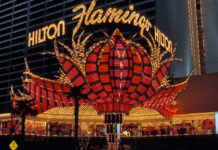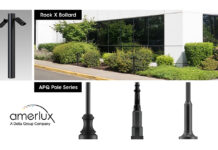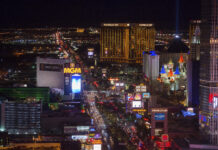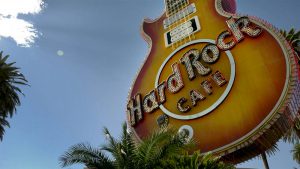 The newly restored Hard Rock Café guitar sign was illuminated for the first time in years during a recent private event at its new home in the Neon Museum’s Boneyard in Las Vegas.
The newly restored Hard Rock Café guitar sign was illuminated for the first time in years during a recent private event at its new home in the Neon Museum’s Boneyard in Las Vegas.
After the Hard Rock Café’s off-strip Las Vegas location closed down in 2016, the sign’s fate was uncertain. But thanks to the joint efforts of the Neon Museum and Young Electric Sign Company (YESCO) Custom Electric Signs, the sign made a comeback worthy of a true rock legend.
A Chart-Topping Hit
The Hard Rock Café guitar sign starts its story in the late ’80s, when Warwick Stone, The Rock Collector™, rock ‘n’ roll art and memorabilia expert, and one of the founding members of Hard Rock’s creative team, came to Las Vegas looking to do something big.
“[Stone] had installed a couple of Cadillacs that were cut in half in front of some Hard Rocks, and he said let’s do something really different,” explains Jeffrey Young, senior vice president of YESCO Custom Electric Signs, a third-generation family-owned company that will celebrate 100 years in 2020.
Stone’s vision was for a giant guitar to sit outside of the Las Vegas location. The only problem was that the estimate for the project was well above what Stone had budgeted.
To make this project a reality, Stone and the Hard Rock opted to lease the sign. “They were able to get a much larger project than they had anticipated, and that sign came to life,” says Young. “Without the financing option, we don’t know what this guitar would’ve looked like.”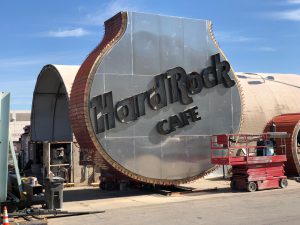
Designing this sign was unlike any other YESCO had done as they were looking to replicate an actual guitar that Stone had always loved—the #9 Gibson Les Paul Deluxe Cherry Sunburst guitar that had belonged to Pete Townshend of The Who.
The actual guitar happened to be in Hard Rock’s possession, which they brought down to YESCO’s offices. “We were able to measure, color match, examine, and review it,” says Young. “It’s uncommon for us to recreate a literal object and particularly one of such renown in rock ‘n’ roll history.”
The final sign—an 80-foot-tall, exact replica of the #9 guitar—was installed outside of the Hard Rock Café at the corner of Paradise Road and Harmon Avenue in 1990. It was the first of what would soon become the recognizable signage symbol of Hard Rocks around the world.
Preparing for a Second Act
The sign stood in front of Hard Rock Café’s Paradise Road location for twenty-seven years before it closed down at the end of 2016. The sign remained standing for a while longer, and the question became what to do with the massive structure.
Hard Rock didn’t have a place for the sign, and since it was under lease, YESCO still owned and had title to it. The sign company didn’t want to see the sign scrapped, so they reached out to the Neon Museum.
YESCO has a long relationship with the Neon Museum, a non-profit organization founded in 1996 dedicated to collecting, preserving, studying, and exhibiting iconic Las Vegas signs. When Las Vegas granted the Museum the ground for the collection and display of the signs, YESCO, who had for years collected old signs in its facility’s backyard, was one of the first donors. “We donated our backyard worth of signs, and then they became a collecting point for a lot of other signs,” says Young.
Today the Neon Museum campus includes the Neon Boneyard outdoor exhibition space, a visitors’ center housed inside the former La Concha Motel lobby, and the Neon Boneyard North Gallery that houses additional rescued signs.
“The Neon Museum has been working to preserve its collection through several means, including full and partial restoration,” says Tracey Sprague, collections manager at the Neon Museum. “Restoration helps maintain the physical appearance of historic signs for generations to come. The museum has restored signs from several decades, highlighting the ever-changing styles of neon signs in Las Vegas from the 1940s to the present day.”
The Neon Museum was interested in the Hard Rock Café guitar sign, but there were a few hurdles to clear before the sign could settle into its new home—namely was there even a place for an eighty-foot-tall sign in the Neon Museum? “There are 200 signs there, but most of them are broken down and 15 to 20 feet tops,” says Young. “So the question became, where in the world would we even put this thing, and would the city even allow it?”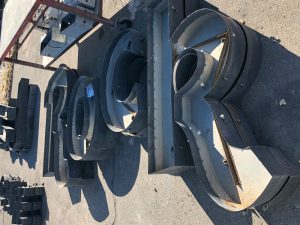
The area the Neon Museum is located in doesn’t allow any structures as high as the guitar sign, but luckily, the City of Las Vegas and Clark County tend to be very flexible with their sign codes.
“They granted us a major exemption to the height restrictions in that neighborhood,” says Young. “And if you drive through there, the neck of that guitar and that guitar towers above everything else that you can see. We were very grateful because this could have been shut down in the city.
“I think there’s a special feeling toward the museum and the history, and an upwelling of support and feeling about this particular guitar and sign, which is the absolute centerpiece, largest of any of the collection and just unbelievable.”
With the sign code issue tackled, the next question was who would pay for the restoration and relocation of the sign?
The Neon Museum has a large following, and they set out to crowdfund the sign’s restoration and maintenance through public relations efforts and appeals to the museum’s extensive database membership. The ongoing campaign ended up being a great success and has raised $232,000 to date from individuals from forty-three states and thirteen countries. The museum is still accepting donations toward the sign’s ongoing maintenance.
Restoring a Legend
YESCO started out the sign renovation by first disassembling the guitar and bringing it to its shop.
Since the support for the sign is vertical, YESCO couldn’t put the sign on its side to complete the restoration. The sign wouldn’t fit inside the shop standing up, so the sign company had to mount it outside of the shop and complete the restoration outdoors.
The decades of use, the move, and an ensuing couple of months waiting in YESCO’s yard for funding led to some broken glass and pieces on the sign. “Although we took great care in disassembling it and bringing it to our yard, it sat in our yard for months and months,” says Young. “By the time we got ready to put it back together, there was quite a bit of neon work. We took every tube of glass we could that was still operable and reused it. And then of course we had to make the rest of the glass and replace the bulbs that were burned out.”
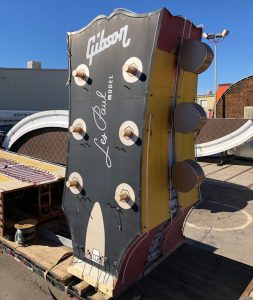 There is approximately 4,110 feet of neon tubing on the sign, which equates to more than three-quarters of a mile and more than 700 individual neon units. Neon colors used on the guitar were ruby red, clear red, 3500K white, and gold II.
There is approximately 4,110 feet of neon tubing on the sign, which equates to more than three-quarters of a mile and more than 700 individual neon units. Neon colors used on the guitar were ruby red, clear red, 3500K white, and gold II.
The Hard Rock letters are bolt-packed and comprise up to 1,538, 10-watt clear incandescent light bulbs, spaced out three inches on center.
The bulbs flash in sequence, which requires a lot of wiring. Almost all of the original wiring was redone except for a number of sockets, which the sign company was able to save.
YESCO worked to keep the guitar’s original finish and didn’t do any refinishing on the outside or neck of the guitar.
“The [800-square-foot] actual face of the guitar was done in a translucent wood grain originally. That was a very, very expensive process, and it did not hold up over time,” says Young. “So because of financing, the Museum elected to reclad the face of the guitar with painted aluminum.”
Comeback Tour
When the restoration was complete, it was time to move the guitar into its new home.
First YESCO got to work on the new massive footing in the outside location the Museum had selected for the guitar sign. The footing included nearly 650 cubic feet of concrete with rebar.
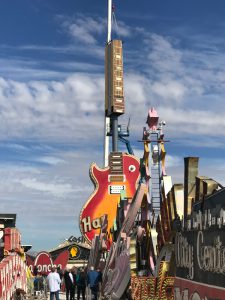 “The place the Neon Museum selected for it worked out perfectly,” says Young. “Right as you walk in, we were able to access that area, dig our footing, and get the new pole planted and welded off so the whole thing will be structurally secure.”
“The place the Neon Museum selected for it worked out perfectly,” says Young. “Right as you walk in, we were able to access that area, dig our footing, and get the new pole planted and welded off so the whole thing will be structurally secure.”
Transporting the sign provided its own challenges. YESCO disassembled it the way it had been assembled originally, which broke up the sign into eight- to ten-foot long pieces except for two sections—the neck and the head of the guitar. The neck measures twenty-three feet long. The head measures thirteen feet, six inches. A special permit was required in order to transport the sign due to its height. The sign pieces were driven over one at a time on a lowboy trailer from YESCO’s shop on the south side of town to the Neon Museum on the north side of town.
Once onsite, YESCO used a Manitex 35124C truck with a 24-ton lifting capacity, 123-foot main boom, and jib with a 165-foot height to assemble the sign. All of the pieces sleeved over the top of the main base pipe and were bolted together.
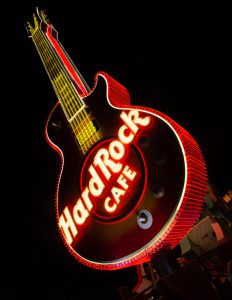 In total, the restoration and installation took about 1,650 man hours to complete.
In total, the restoration and installation took about 1,650 man hours to complete.
“I have to pinch myself that a sign we built in 1990, during my career, won’t just be another one of the signs that no one ever sees again,” says Young. “It’s going to be in a place where it’s cared for, it’s adored, it’s viewed, it’s photographed, and it’s going to be there literally for generations to come.”
By Ashley Bray
All Photos: The Neon Museum


